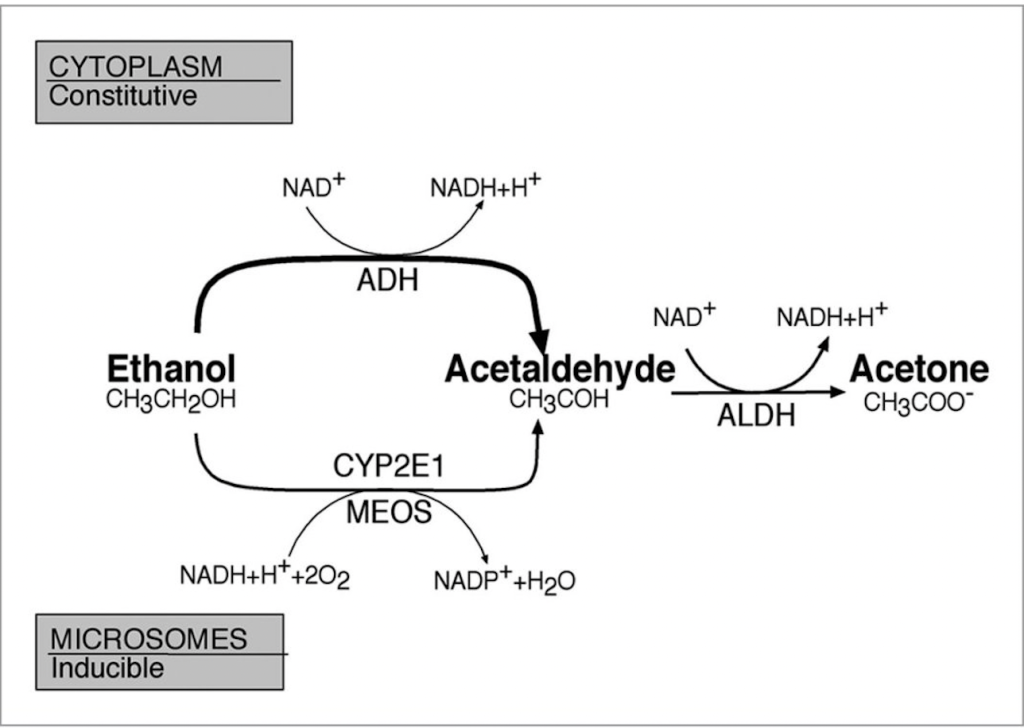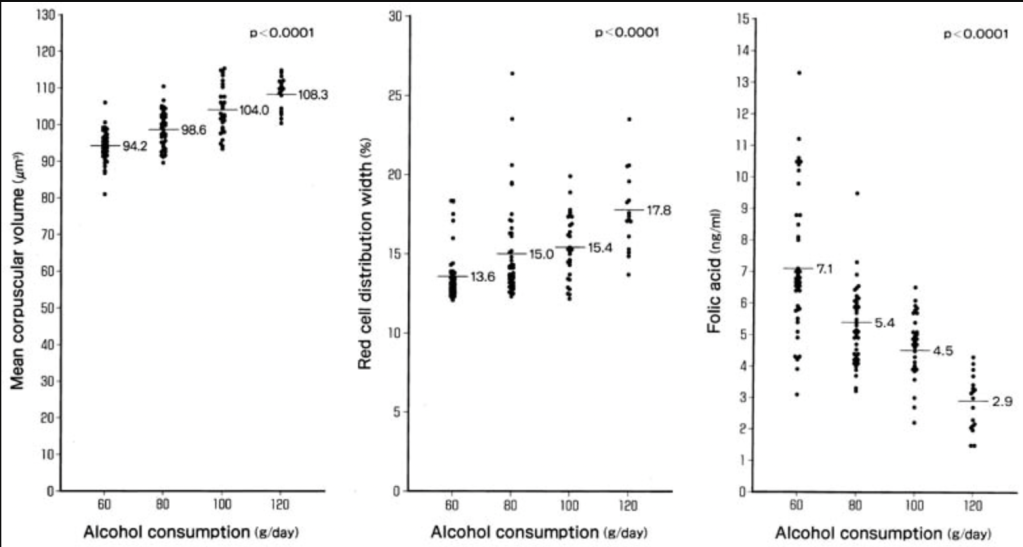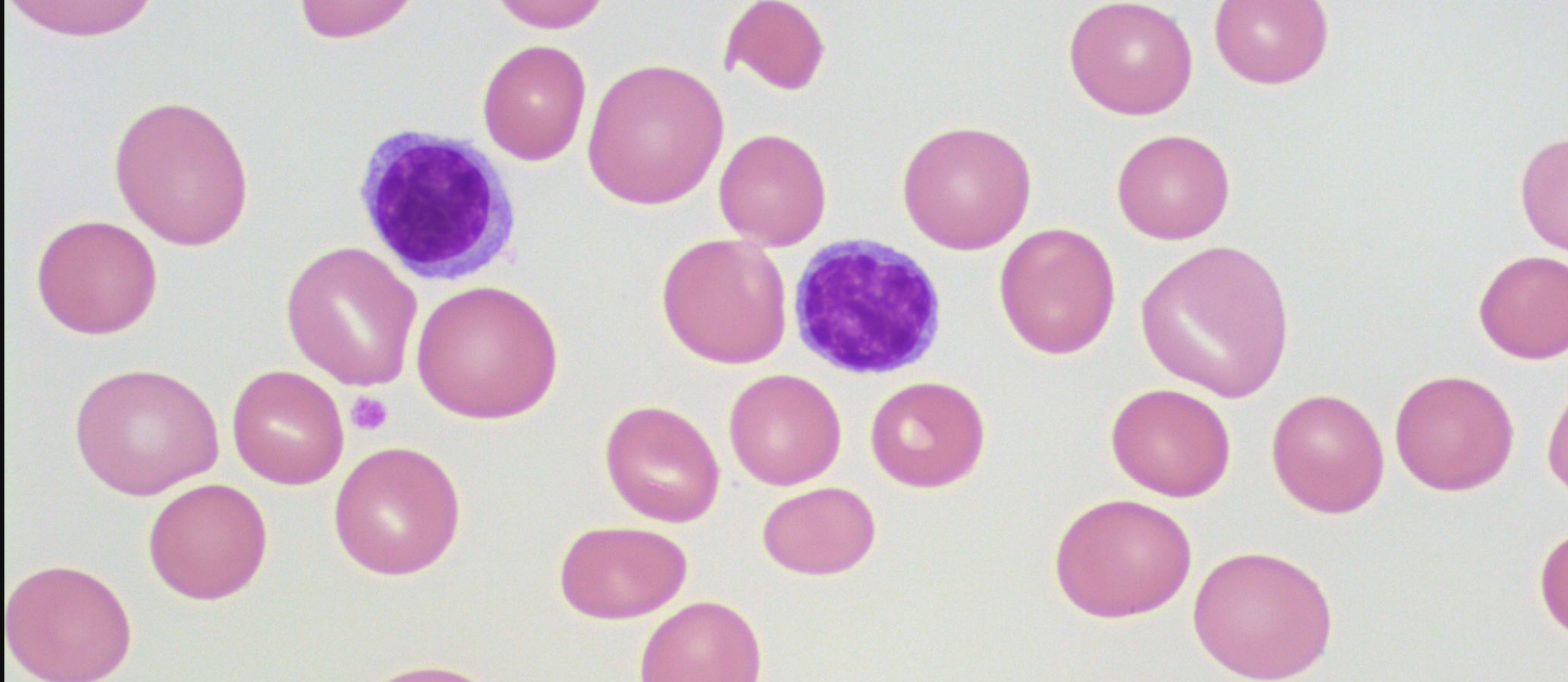Why does chronic alcohol use cause macrocytosis?
Previously on the Curious Clinicians, we’ve discussed some of the physiologic effects of alcohol that may be familiar to many: Feeling warm and peeing a lot. On this episode, we discuss another effect that is likely only seen by clinicians. Macrocytosis, or enlarged red blood cells (RBCs), is a common finding in patients with chronic alcohol use. It’s easy to chalk up a mild macrocytosis to someone’s alcohol use without pausing to think “But why does alcohol cause macrocytosis in the first place?” And you all know by this point that on the Curious Clinicians, we have to ask why.
Let’s first discuss what macrocytosis is. The size of RBCs is measured in a tiny unit of measurement called femtoliters (fL), or 10-15 liters, and a normal RBC is anywhere from 80 to ~100 fL. That measurement is called the mean corpuscular volume (MCV). RBCs that have an MCV of >100 fL are macrocytic, and those with an MCV of <80 fL are microcytic. Common causes of microcytosis are iron-deficiency and the various thalassemias. In one study of 300 patients with MCV >100 fL (macrocytosis), the most common cause was medications (37%). Some other well-known causes of macrocytosis are B12 and folate deficiencies, myelodysplasia and reticulocytosis (as the immature RBCs are larger than normal). NB: Although the terms are sometimes used interchangeably, “megaloblastosis” refers specifically to the macrocytosis often seen in B12 and folate deficiencies, where the RBC progenitors mature too slowly and form large, non-functional cells.

In the same study, though, an equal number of cases (13% each) could be attributed to alcohol-related liver disease and alcohol consumption without liver disease. In the 1930’s at Johns Hopkins, clinicians established a connection between alcohol-related liver disease and macrocytosis, but assumed it was the liver disease itself causing it. This is true, in part, as liver disease may alter cholesterol metabolism and therefore RBC membrane size. But as one 2001 study from Japan showed, in patients with various types of liver disease, those with alcohol-related ones had a dose-dependent relationship between RBC size and daily alcohol consumption. In other words, the more alcohol they drank, the bigger their RBCs got.

So is alcohol (aka ethanol) doing something to the RBCs itself? In one study, white blood cells (WBCs) were incubated with pure ethanol and showed no increase in size. However, when incubated with acetaldehyde, the metabolite of ethanol that the liver and gut produce via alcohol dehydrogenase, they did grow. Although this was a study of WBCs, not RBCs, it suggests that acetaldehyde, not alcohol, is what causes macrocytosis.
The most likely mechanisms through which acetaldehyde causes RBC enlargement are through (1) membrane and cytoskeletal composition changes and (2) fluid shifts. Acetaldehyde can bind to cytoskeleton proteins like actin and spectrin and form adducts (stably-bonded complexes). One 2001 study sampled the bone marrow of 20 patients with macrocytosis, 11 of whom had chronic excessive alcohol use. The researchers then stained the samples to test for acetaldehyde presence in RBC progenitor cells. 73% of the alcohol users had acetaldehyde bound to their membranes, whereas none of the controls did. Furthermore, when the researchers separated proteins from peripheral RBCs using chromatography, alcohol-using patients had higher frequencies of acetaldehyde-bound proteins. Normally, the RBC membrane is able to be strong-yet-flexible due to the dynamic movement of cytoskeleton proteins. In chronic alcohol use, the acetaldehyde-protein clumps don’t allow the membrane to hold its shape, causing it to balloon out.
The fluid shifts are due to furosemide-sensitive Na⁺-K⁺-Cl⁻ membrane co-transporters which actually exist on RBCs and many other cell types in addition to in the kidneys. These membrane proteins allow Na⁺ to enter the RBC, which then promotes inward movement of fluid to balance the osmolality. This mechanism protects the RBC from shrinking when the blood plasma osmolality rises. Furosemide inhibits this process, much like it inhibits Na⁺ absorption in the Loop of Henle. Acetaldehyde has the opposite effect – it stimulates the co-transporter, leading to excessive Na⁺, and therefore water, movement into the RBC, causing it to swell. One 1988 study immersed live/functioning rat livers in solutions of either ethanol or acetaldehyde, with both agents causing a ~9% increase in cell water content. When the ethanol solution was combined with methylpyrazole, an inhibitor of alcohol dehydrogenase (the enzyme that produces acetaldehyde), no cell swelling occurred. Furthermore, when either ethanol or acetaldehyde solutions were combined with bumetanide (a loop diuretic similar to furosemide), no swelling occurred either. This is strong evidence for these co-transporters being involved in maintaining cell size, and that acetaldehyde (not ethanol) is what causes macrocytosis.

Although alcohol can cause several types of hemolytic anemia, alcohol use does not seem to cause macrocytosis via reticulocytosis. The toxic effects of alcohol on erythroblasts include disrupting iron metabolism. Reticulocytosis is thus only then seen upon abstinence as the body supercharges RBC production.
It is true that many patients with chronic alcohol use have nutrient deficiencies (e.g. B12, folate) and liver disease, and these could all contribute to macrocytosis.
Take Home Points
- Alcohol-induced chronic macrocytosis is mediated primarily by acetaldehyde as an alcohol metabolite, in addition to folate or B12 deficiency and liver disease, if present
- Acetaldehyde increases red blood cell size by 2 main purported mechanisms:
- Altered membrane shape and composition by cross-linking cytoskeletal proteins
- Stimulation of red blood cell Na⁺-K⁺-Cl⁻ membrane cotransporters, leading to Na⁺ influx and cell swelling
Link to Related Tweetorials
Listen to the episode
https://directory.libsyn.com/episode/index/id/30475793
Credits & Citation
◾️Episode written by Avi Cooper
◾️ Show notes written by Giancarlo Buonomo and Avi Cooper
◾️Audio edited by Clair Morgan of nodderly.com
Image Credit: Marion Fraser, University of Alberta
CME/MOC
Click here to obtain AMA PRA Category 1 Credits™ (0.5 hours), Non-Physician Attendance (0.5 hours), or ABIM MOC Part 2 (0.5 hours).
As of January 1, 2024, VCU Health Continuing Education will charge a CME credit claim fee of $10.00 for new episodes. This credit claim fee will help to cover the costs of operational services, electronic reporting (if applicable) and real time customer service support. Episodes prior to January 1, 2024, will remain free. Due to system constraints, VCU Health Continuing Education cannot offer subscription services at this time, but hope to do so in the future.

